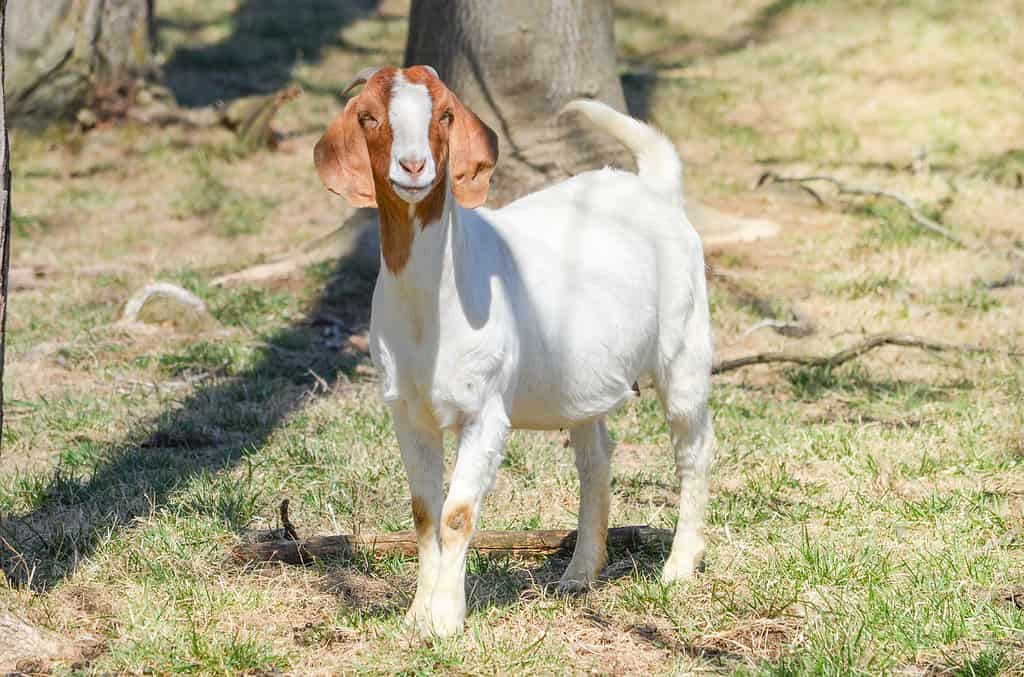Boer Goat
Capra hircus
Most popular meat goat in the world
Advertisement
Boer Goat Scientific Classification
- Kingdom
- Animalia
- Phylum
- Chordata
- Class
- Mammalia
- Order
- Artiodactyla
- Family
- Bovidae
- Genus
- Capra
- Scientific Name
- Capra hircus
Read our Complete Guide to Classification of Animals.
Boer Goat Conservation Status
Boer Goat Facts
- Name Of Young
- kid
- Group Behavior
- Herd
- Fun Fact
- Most popular meat goat in the world
- Estimated Population Size
- Tens of millions
- Most Distinctive Feature
- Reddish-brown heads and necks
- Distinctive Feature
- Backward-curving horns
- Other Name(s)
- Boerbok
- Gestation Period
- 150 days
- Temperament
- Docile
- Litter Size
- 2
- Habitat
- Thorn veld
- Predators
- Lions, hyenas, wild dogs
- Diet
- Herbivore
- Lifestyle
- Diurnal
- Favorite Food
- Hay, leaves, brush, shrubs
- Origin
- South Africa
- Number Of Species
- -1
- Location
- Worldwide
Boer Goat Physical Characteristics
- Color
- Brown
- Red
- White
- Skin Type
- Hair
- Lifespan
- Up to 20 years
- Weight
- Up to 400 pounds
- Height
- Up to 44 inches
- Age of Sexual Maturity
- 5 months
- Venomous
- No
- Aggression
- Low
View all of the Boer Goat images!
Also known as the Boerbok, the Boer goat (Capra hircus)is a breed of goat indigenous to South Africa. The largest goat breed in the world, they can exceed 300 pounds. They are often raised for meat due to their hardiness, size, excellent carcass quality, and high reproductive rate. In fact, many experts regard these goats as the best meat goats in the world. You can now find them around the world thanks to their popularity as meat goats, show goats, and in vegetation management.
5 Boer Goat Facts
- The Guinness World Record for the largest goat belongs to Mostyn Moorcock, a Boer goat that weighed nearly 400 pounds and stood 44 inches tall at the shoulder.
- On average, babies weigh around 8 pounds at birth.
- A registered Boer got doe can cost around $600, while a buckling of good stock can cost around $1,200.
- The American Boer Goat Association registers over 45,000 new Boer goats every year.
- They can thrive in semi-arid savanna or thornveld habitats that many goats would find unlivable.
Scientific Name
Like all domestic goats, the Boer goat belongs to the family Bovidae. It is a member of the genus Capra. The term capra derives from the Proto-Indo-European term kapros, meaning “he-goat” or “billy goat.” Similarly, its specific name, hircus, also has Proto-Indian-European roots of unknown origins and roughly translates to “goat.” Meanwhile, the their common name stems from the Dutch word boer, meaning “farmer.” Dutch immigrants to South Africa likely chose this name for them to differentiate it from imported Angora goats.
Appearance

A junior-aged Boer goat.
©DonnaA Country Photos/Shutterstock.com
Most Boer goats have a white body and reddish-brown head and neck. That said, some can appear almost completely brown, white, or painted. Painted variants feature spots of varying colors across their bodies. You can differentiate males from females by their larger size and characteristically long neck hair. Both males and females grow backward-curving horns, with male horns typically measuring longer and thicker at the base. These goats also have long, downward-hanging ears.
The Boer goat is the largest goat breed in the world. Adult females can grow up to 250 pounds, although most females weigh around 200 pounds. Meanwhile, adult males average around 250 pounds but can reach up to 350 pounds or more. Both females and males stand around 30 inches tall at the shoulder, although some specimens can stand up to 44 inches.
Evolution and History
The history of the Boer goat begins over 100 years ago, in the early 1900s. Around the start of the 20th century, Dutch farmers in South Africa bred them by breeding European, Angora, and Indian goats with native goats kept by local Namaqua, San, and Bantu-speaking tribes. Specifically, Boer goats likely originated in the Eastern Cape Province when ranchers and farmers in that region began breeding them for meat production. This breed of goat made its way around the world over the next few decades, arriving in the United States around 1994.
Behavior
Despite their large stature, they enjoy a reputation as a calm, docile breed. Their calm disposition makes them popular not only as meat goats but also as companion goats. Unlike some breeds, this goat does not require as much rope or climbing equipment in their pens to keep entertained. Additionally, they are much easier to keep in fenced paddocks compared to other more excitable breeds.
Habitat
Traditionally speaking, full-blood Boer goats hail from South Africa. To be more precise, the first Boer goats originated in the Eastern Cape Province in southeastern South Africa. Boer goats in the area browsed primarily in the semi-arid, thorn veld savannas and grasslands common in that region. Thorn veld habitats frequently contain hardy, thorny plants such as acacia as well as tough native grasses. However, while Boer goats originated in these habitats, you can now find them in various landscapes around the world. Today, they are commonly kept as meat goats throughout New Zealand, Australia, the UK, and the United States.
Boer Goat Diet
Like all goats, they are browsers. Their diet consists mostly of leaves, shrubs, brush, hay, fruit, and vegetable scraps. Common hay sources include crops like lespedeza and alfalfa. Other popular protein sources include beans, soybeans, cowpea, and acacia pods. Although they primarily graze on thorny acacia shrubs and bushes in their native habitats in South Africa, Boer goats are well-adapted to survive in various environments. In South Africa, Boer goats primarily browse on Themeda and Hyparrhenia grasses, acacia bushes, cabbage trees, and buffalo thorns. That said, the types of plants will vary depending on the region. What doesn’t change is the amount of food that they need to eat. The typical Boer goat needs to eat between 3% and 4% of its body weight in feed every day.
Predators and Threats
Due to their status as domestic animals, Boer goats don’t have to worry about predators as much as wild goats. That said, they still have their fair share of predators. The list of Boer goat predators varies depending on the location. In their native South Africa, traditional predators of Boer goats include lions, hyenas, and leopards. In other parts of the world, common goat predators include coyotes, mountain lions, and wolves.
Reproduction and Life Cycle
Boer goats are an extremely fast-growing breed, which is one reason why they make such excellent meat goats. Additionally, unlike some other goat breeds, they can breed year-round. On average, most of them reach sexual maturity at around 5 months old. Most breeders have ewes produce three crops of kids every 2 years. After their first birthing, female Boer goats almost always give birth to two kids. Many breeders remark that ewes possess exceptional mothering instincts compared to other goat breeds. A Boer got kid typically weighs around 8 pounds at birth, but can weigh nearly 80 pounds by around 3 months old.
Most Boer goats raised for meat are killed before they reach 5 years old. Younger goats can also be harvested as young as 5 months old. However, Boer goats can live up to 20 years if given the proper care.
Boer Goat Population
From its humble origins in South Africa, the Boer goat grew into one of if not the most popular meat goat breeds in the world. Today, you can find them all over the world. Numerous goat associations keep track of their populations, trends, and registrations. The American Boer Goat Association registers around 45,000 of them every year. Although their population in South Africa has declined in recent years, the country still boasts a population of between 1 and 2 million goats, while the continent as a whole has around 5 million goats. Due to its widespread distribution and popularity, this particular breed of goat is not considered an “At Risk” breed by any major regulatory or conservation organization.
View all 285 animals that start with BBoer Goat FAQs (Frequently Asked Questions)
Are Boer goats omnivores, herbivores, or carnivores?
Boer goats are herbivores that primarily feed on leaves, brush, shrubs, hay, vegetables, and fruit.
How much food do Boer goats need per day?
On average, Boer goats need to eat between 3% and 4% of their body weight in feed per day. that equate to roughly 8 to 10 pounds per day, depending on the goat.
What’s the difference between a purebred and full-blood Boer goat?
Purebred Boer goats are created by breeding Boer goats with another breed over several generations (4 for does and 5 for bucks). Meanwhile, full-blood Boer goats are descended on both the sire and dam sides from Boer goats that trace their ancestry back to South Africa. A purebred Boer got can never become a full-blood Boer goat.
How many does can a buck Boer goat mate with?
Most Boer goat breeders follow the 3% rule (i.e., for every 100 does, you should have 3 bucks). That said, older bucks can breed with more females than younger bucks.
Thank you for reading! Have some feedback for us? Contact the AZ Animals editorial team.
Sources
- 03/18/2023, Available here: https://www.abga.org/history
- 03/18/2023, Available here: https://content.ces.ncsu.edu/breeds-and-production-traits-of-meat-goats
- 03/18/2023, Available here: https://breeds.okstate.edu/goats/boer-goats.html
- 03/18/2023, Available here: https://extension.psu.edu/animals-and-livestock/goats/reproduction-and-genetics

















